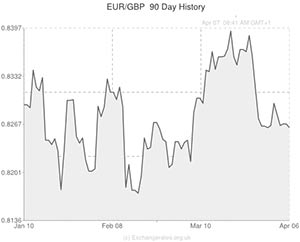
As the European session progressed on Monday the Euro to Pound (EUR/GBP) pairing was trading moderately higher.
While Pound movement was stilted due to a lack of influential economic news for the UK, the Euro was boosted by a stronger-than-forecast increase in German industrial output.
The German industrial production report showed that output increased for a fourth month in February, rising by 0.4 per cent month-on-month rather than the 0.3 per cent expected.
January’s gain was revised down to 0.7 per cent.
On the year, industrial production was up 4.8 per cent, more than the 4.7 per cent annual increase expected but down from January’s figure of 4.9 per cent.
Mild weather was cited as one of the main factors behind Germany’s strong economic performance in the first quarter of 2014.
Meanwhile, volatility in developed nation currencies like the Euro dropped to its lowest level for nearly seven years.
Bloomberg News quoted analyst Divya Devesh as saying this of the absence of notable currency movement; ‘It’s partly a lack of strong conviction based on data not being very clear. That doesn’t mean we won’t see a trend in the coming weeks. In fact we think US Treasury yields will rally and the Dollar will also rally on the back of that.’
The Euro received additional support as the Eurozone Sentix investor confidence measure climbed from 13.9 in March to 14.1 in April.
However, Sentix did report yesterday that Germany’s composite index fell for a third consecutive month in April, with the gauge slipping from 30.7 to 28.9.
In a statement issued with the figures it was said that ‘While 6-month expectations have been dragging down the indicator over the past months, it is now also the assessment of the current situation which is not lending support to the composite index anymore. The German economy thus loses steam. The big question now is how the Eurozone economy will react to this. Still, it is looking robust: the composite index for the Euro area increases, once more, slightly. But expectations are down a little for the second consecutive month.’
The Pound experienced minimal fluctuations following the release of the UK’s Lloyds Employment Confidence report for March. The measure came in at -2, unchanged from February.
As the week continues considerable Euro to GBP volatility can be expected, and investors will be paying particular attention to the UK NIESR GDP estimate for March, the Bank of England’s rate decision and German inflation data.
If the BoE adopts a hawkish tone in this week’s statement the Pound could recover losses against the Euro and breach the 1.21 barrier it’s been testing over the last month.
Euro Exchange Rates
[table width=”100%” colwidth=”50|50|50|50|50″ colalign=”left|left|left|left|left”]
Currency, ,Currency,Rate ,
Euro, ,Pound Sterling,0.8276,
,Pound Sterling,0.8276,
Euro, ,US Dollar,1.3715,
,US Dollar,1.3715,
Euro, ,Canadian Dollar,1.5075,
,Canadian Dollar,1.5075,
Euro, ,Australian Dollar,1.4766,
,Australian Dollar,1.4766,
Euro, ,New Zealand Dollar,1.5934 ,
,New Zealand Dollar,1.5934 ,
US Dollar, ,Euro ,0.7292,
,Euro ,0.7292,
Pound Sterling, ,Euro,1.2085,
,Euro,1.2085,
Canadian Dollar, ,Euro,0.6633,
,Euro,0.6633,
Australian Dollar, ,Euro,0.6772,
,Euro,0.6772,
New Zealand Dollar, ,Euro,0.6273,
,Euro,0.6273,
[/table]

Comments are closed.